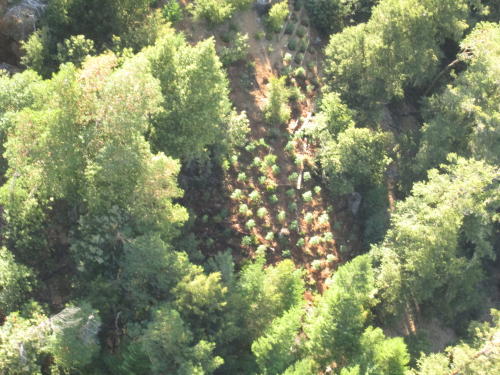
Here’s a news story from California.
Below is an excerpt.
When deputies arrived on scene they located a large marijuana growing operation containing 5,266 growing marijuana plants ranging in size from 1′ to 4′ in height. They also located an armed suspect in the garden who was arrested. The suspect was identified as Andres Montes-Deoca, 21 years old, from Mexico. When deputies arrested Montes-Deoca he was wearing a loaded 9 mm semi-automatic handgun.
Officers also located a Rodenticides and Carbofuran in the garden site.
I remember using carbofuran on pine seedlings for (root weevils??) It was 35 or so years ago. I remember that stuff being very bad and here’s a wikipedia entry that it’s indeed very, very bad for many organisms including humans.
Carbofuran is highly toxic to vertebrates with an oral LD50 of 8–14 mg/kg in rats and 19 mg/kg in dogs.[citation needed]
Carbofuran is known to be particularly toxic to birds. In its granular form, a single grain will kill a bird. Birds often eat numerous grains of the pesticide, mistaking them for seeds, and then die shortly thereafter. Before the granular form was banned by U.S. Environmental Protection Agency in 1991,[11] it was blamed for millions of bird deaths per year. The liquid version of the pesticide is less hazardous to birds since they are not as likely to ingest it directly, but it is still very hazardous. The EPA announced on July 25, 2008 that it intends to ban all forms in the US.[12] The ban requires that no residue be present on domestic or imported foods.[13]
Carbofuran has been illegally used to intentionally poison wildlife in the US, Canada and Great Britain; poisoned wildlife have included coyotes, kites, golden eagles and buzzards. Secondary fatal poisoning of domestic and wild animals has been documented,[14][15] specifically, raptors (bald eagles and golden eagles), domestic dogs, raccoons, vultures and other scavengers. In Kenya, farmers are using carbofuran to kill lions and other predators.[9][16]
In a number of publicized incidents worldwide, carbofuran has also been used to poison domestic pets.[17][18]
Toxicity to humansCarbofuran has one of the highest acute toxicities to humans of any insecticide widely used on field crops (only aldicarb and parathion are more toxic). A quarter teaspoon (1 mL) can be fatal.[citation needed] Most carbofuran is applied by commercial applicators using closed systems with engineered controls so there is no exposure to it in preparation. Since its toxic effects are due to its activity as a cholinesterase inhibitor it is considered a neurotoxic pesticide.
Carbofuran is also a powerful endocrine disruptor that can cause transient alterations in the concentration of many hormones in animals and humans even at extremely low doses. These alterations may consequently lead to serious reproductive problems following repeated exposure.[19][20] In one study, the exposure of rats to sublethal amounts of carbofuran decreased testosterone by 88%, while the levels of progesterone, cortisol, and estradiol were significantly increased (1279%, 202%, and 150%, respectively).[19]
Carbofuran can also be toxic to testes in sublethal amounts. A decrease in sperm motility, sperm count along with increase in percent abnormal sperm was observed at 0.4 mg/kg dose level.[21]